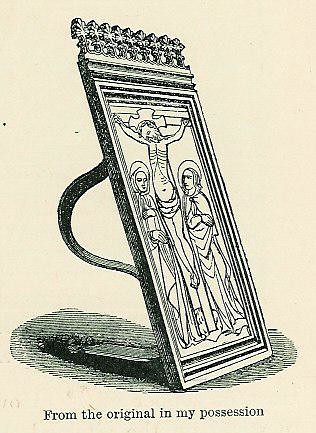Here is a Western 'icon' that was used liturgically from at least the 13th c. (AD 1200's) for the Kiss of Peace.
From Daniel Rock's "The Church of Our Fathers", 1849:
"Instead of the clerk's cheek, the priest kissed the figure of our Blessed Lord, painted on a small piece of wood, or graven on a plate of copper, set in a frame, with a handle behind, as is shown in this cut. So shaped, it could easily be carried about among the people by the clerk, in his left hand; and, after each kiss bestowed upon it, wiped with a little napkin which he held for that purpose in his right hand. The earliest mention anywhere of such a ritual appliance, is to be found among this country's ecclesiastical enactments, in which it is called "osculatorium," "asser pacis," "tabula pacis."28 Its more common name was "pax-brede," which at once told its liturgical purpose, and of what material it happened, at first, to be generally made. Afterwards, gold, silver, ivory, jewels, enamel, and the most beautiful workmanship, were bestowed upon it; though, for poor churches, it still continued to be made of wood, or at most, of copper gilt.
--------------
28 Among other sacred things to be found by the parishioners for their church, according to the statutes of Archbishop Walter Gray, for his province of York (A.D. 1250), was "osculatorium." (Wilkins, Concil., i. 698.) In like manner the synod of Exeter (A. D. 1287) decreed there should be "asser ad pacem" (ibid., ii. 139), and the council of Merton (A.D. 1305), "tabulas pacis ad osculatorium" (ibid., 280). "
The pax-brede, along with the Eulogiae (holy bread) was withheld from hardened sinners first among items barred from those excommunicated. The Gospel was also used as such at High Masses in Cathedrals (like the Gospel at Byzantine Orthros.)
Also from Daniel Rock D.D. Canon of the English Chapter (Roman Catholic):
"In going to meet, for the first time, that pagan king, St. Austin and his holy fellow-labourers went forward carrying for a banner a silver cross and the image of our Lord and Saviour painted on a board.... The use of images and pictures in churches, is well defended by this great Anglo-Saxon father [Venerable Bede] in another part of his writings; and he shows that as under the Old, so in the New law, the employment of images is quite allowable: [referring to the Venerable Bede's commentary on Exodus]... Upon the principle that the Church is the teaching-house of holiness, therefore the walls themselves about the earthly building should speak of heaven... upon this principle was it that the Anglo-Saxons strove their best to get the images of Christ, of his ever-virgin mother, of the apostles and of the saints, and to look for artists who might paint subjects from holy writ, to adorn the walls of their churches.... On going, then, into an Anglo-Saxon minster, here and there might be seen, done in bronze, or some one or other of the more valuable metals, representations of the life and miracles of our divine Redeemer. But in those places where it could be procured, the whole inside of the church was covered with paintings of the saints, and illustrations of passages of holy writ. "
See: PaintedChurch.org for surviving examples.
2.18.2005
Subscribe to:
Post Comments (Atom)

No comments:
Post a Comment